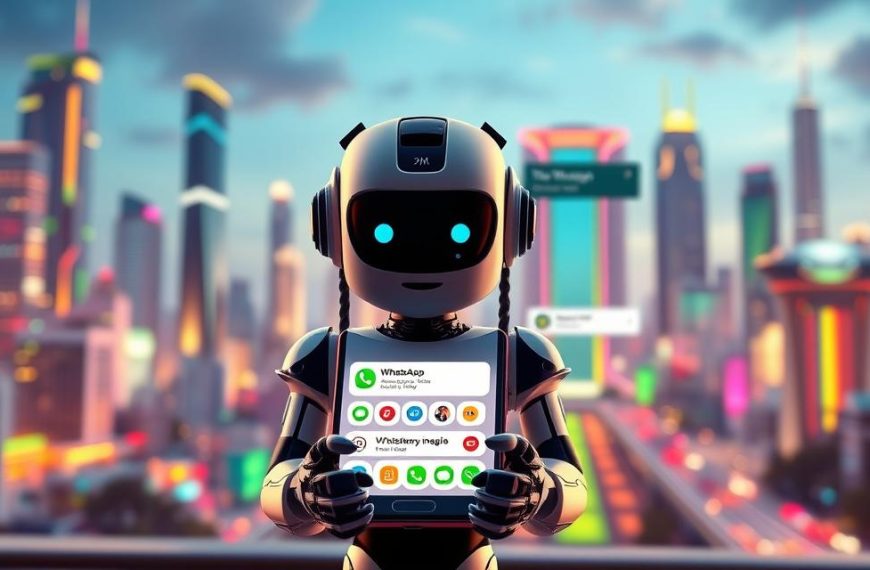Today, more companies use AI chatbot software on Meta’s messaging platform. These tools handle customer queries, process orders, and give personal responses 24/7. They work with systems like Zendesk to keep the brand’s voice consistent everywhere.
These bots are great for saving time. They answer quickly, unlike old support methods. Retailers track deliveries, and service providers book appointments. This makes businesses better at serving customers in a fast-paced world.
Smart brands use these bots for conversational marketing. Instead of generic ads, bots have real chats with users. They suggest products based on what you’ve done before, help with forgotten carts, or ask for feedback. This way, they boost sales and build trust by being quick and understanding.
As people’s needs change, these tools are key for Meta users. They save money and give valuable insights from real-time data. From small shops to big companies, using automated messaging shows a focus on meeting customers where they are – in their social media.
Understanding Facebook Messenger Chatbots
Today, businesses use automated messaging tools to make talking to customers easier. Facebook Messenger chatbots lead this change, combining smart tech with useful chat solutions. Let’s see why they’re key for businesses now.
Definition and Core Functionality
A Facebook Messenger chatbot is a smart program that talks like a human in Meta’s chat. It mainly does two things: understand what users say and give quick answers. Key functions include:
- Automated query resolution using NLP technology
- Seamless handover to human agents when needed
- Personalised content delivery based on user data
Key Components of Chatbot Architecture
Good chatbot architecture has three main parts:
- Natural Language Processing Engines: Turn user messages into data that computers can read (e.g., Meta’s Wit.ai platform)
- Decision-Making Frameworks: Rules or AI that decide the right answers
- Integration APIs: Link chatbots to CRM systems like Zendesk or platforms like Glassix
Meta’s setup helps these parts work better. It has features like ID matching and chat extensions. For example, a shop chatbot might send tricky questions to the right team while handling simple ones itself.
How Messenger Chatbots Operate
Every good Messenger chatbot uses smart language understanding and technical skills. They mix artificial intelligence with business software. This makes user experiences smooth and automates important tasks.
Natural Language Processing Fundamentals
Chatbots rely on natural language processing (NLP) to get what users say. Meta’s Wit.ai helps bots:
- Find important phrases like “track order” or “cancel subscription”
- Understand feelings by looking at word choices
- Turn casual requests into clear commands
This tech makes Sunshine Conversations’ answers smart. They adjust to local speech and slang. A developer says:
“Modern NLP doesn’t just look at words – it gets what you mean by understanding patterns from lots of chats.”
Integration With Business Systems
Chatbots really shine when they link up with business systems. Glassix’s platform shows how system connectivity turns simple chats into useful actions.
CRM and Payment Gateway Connections
Important connections include:
| Platform | CRM Integration | Payment Automation |
|---|---|---|
| Zendesk | Auto-ticket creation | Stripe/PayPal links |
| Chatfuel | Lead scoring | Shopify cart recovery |
| Sunshine Conversations | Customer history access | Subscription management |
These links let chatbots do things like update Salesforce records or handle refunds. Retailers using Chatfuel’s e-commerce tools see 35% quicker checkouts thanks to payment automation.
Strategic Benefits for Modern Businesses
Modern companies use Messenger chatbots to tackle big challenges and improve customer service. These AI tools bring big wins in three areas: service, engagement, and making money.
24/7 Customer Service Capabilities
Messenger chatbots fill service gaps by answering fast, no matter the time or staff. KLM Royal Dutch Airlines cut response times from 45 minutes to under 60 seconds. They handle 1.7 million queries each year on their own.
Reducing Response Times and Staff Workload
AI systems are great at answering simple questions and passing on tough ones to people. This makes work more efficient:
| Metric | Traditional Support | Chatbot Implementation |
|---|---|---|
| First Response Time | 8 hours 12 mins | 23 seconds |
| Resolution Rate | 68% | 89% |
| Cost Per Interaction | $6.50 | $1.20 |
Lead Generation Optimisation
Chatbots turn website visitors into leads through interactive chats. Joybird, a furniture store, boosted lead capture by 214% with a sofa quiz. It suggests furniture based on users’ homes and style.
Qualifying Prospects Through Conversational Marketing
Chatbots ask smart questions to find the best leads and guide others with the right content. A marketing director shares:
“Our chatbot asks about budget, timeline, and project scope in 90 seconds. It quickly finds clients ready to buy and helps others with info.”
Sales Conversion Enhancement
Chatbots boost sales by making timely offers and personal recommendations. Stores using cart recovery see 23% average recovery rates. Top ones get over 35% with special deals and shipping promises.
Here are three ways to speed up sales:
- Update product availability in real-time during checkout
- Show AI comparisons with items left behind
- Offer limited-time deals to encourage quick buys
Practical Business Applications
Facebook Messenger chatbots are changing how businesses work. They offer custom solutions that make things easier and better for customers. Let’s see how different sectors use them to tackle real problems.
Retail Sector Implementations
Retailers use chatbots to link online and in-store shopping. For example, ASOS has style advice bots. These bots look at what you’ve browsed to suggest outfits. It’s a great example of retail automation making shopping more fun.
Order tracking and personalised recommendations
Now, systems keep customers updated on their orders and suggest more products. This helps cut down on support questions by 40%, Zendesk’s retail studies show.
| Feature | Retail Benefit | Implementation Example |
|---|---|---|
| Real-time inventory checks | Reduces abandoned carts | ASOS size recommendation engine |
| Upsell prompts | Increases average order value | Nike’s accessory suggestions |
| Loyalty integration | Boosts repeat purchases | Sephora Beauty Insider updates |
Service Industry Use Cases
In salons and healthcare, service industry chatbots manage bookings and gather feedback. Decathlon’s sports clinic booking bot shows how these systems can handle:
- Same-day appointment changes
- Pre-consultation questionnaires
- Post-service ratings
Appointment scheduling and feedback collection
These bots reduce no-shows by 25% with reminders and rescheduling. They also track service quality across places.
Event Management Solutions
Conference chatbots, inspired by Bumble, help with attendee networking and planning. Key features include:
- AI session suggestions
- Live Q&A during speeches
- Post-event surveys
Organisers of tech conferences see a 30% jump in attendee happiness with these tools over traditional apps.
Implementation Roadmap
Creating a Messenger chatbot needs careful planning. It’s about matching technical skills with business goals. This plan covers choosing platforms, designing conversations, and making improvements.
Platform Selection Criteria
Deciding between making your own or using third-party tools depends on a few things. These are your budget, the skills of your team, and how much you need to grow. La Vie en Rose found they could solve problems 40% faster with Chatfuel’s templates than starting from scratch.
Comparing Self-Built vs Third-Party Solutions
| Factor | Self-Built | Third-Party |
|---|---|---|
| Initial Cost | $15k-$50k | $200-$2k/month |
| Maintenance | Dedicated team required | Included in subscription |
| Customisation | Full control | Template-based |
Conversation Flow Design
Good decision trees help users avoid getting stuck. Zendesk suggests:
- Listing all possible customer needs
- Setting up paths to human help
- Testing the logic with example chats
Creating Effective Decision Trees
Glassix’s data shows chatbots with 3-click solutions make users happier by 68%. Make sure to include:
- Clear menu choices
- Back-up answers for unknown questions
- Smooth handovers to humans
Testing and Optimisation Strategies
Do A/B tests every two weeks. Compare things like:
- How accurate the chatbot is
- How often chats are finished
- How happy users are
Update your chatbot plan every three months with new data. One travel company boosted sales by 22% by always testing their chatbot’s layout.
Performance Measurement Techniques
High-performing chatbots are identified by advanced measurement tools. Businesses need to mix numbers with feedback to see their bot’s real effect. This method shows how to improve and proves the value of AI.
Key Metrics Analysis
Good chatbot analytics focus on three main metrics:
- Response accuracy (85%+ target): Checks if answers solve user questions alone
- Conversation completion rate (70%+ ideal): Sees if talks are finished well
- Containment percentage (90%+ goal): Finds issues solved without needing a human
Response Accuracy and Conversation Completion Rates
Brands like Tiffany & Co hit 92% containment with smart chatbot features. Their bots use visual hints to:
- Set user hopes during delays
- Keep talks interesting in complex chats
- Help users reach their goals
Continuous Improvement Cycles
Regular updates make chatbots better. Glassix’s tools check chatbot mood in real-time. This helps improve chatbot quality by:
| Metric | Optimisation Trigger | Improvement Cycle |
|---|---|---|
| Negative Sentiment | 15%+ of interactions | 48-hour dialogue review |
| Fallback Rate | 20%+ per intent | Weekly training data updates |
“Our typing indicators cut user drop-offs by 37% – they turn waits into chances to engage.”
To really measure chatbot success, use these strategies with A/B tests and user feedback. Regular checks keep your bot up-to-date with customer needs. This also keeps it in line with GDPR and quality standards.
Common Implementation Challenges
Messenger chatbots bring many benefits, but they also come with challenges. Businesses face hurdles that need smart solutions. Three big challenges stand out when setting up chatbots.
Managing Data Protection Requirements
Meta’s data rules meet strict laws like GDPR compliance. This creates a complex privacy area. Companies must tell users why they collect data and get their consent. Decathlon makes it clear how they use data when you first talk to their bot.
Important things to think about include:
- Deleting sensitive data after it’s processed
- Using end-to-end encryption for payment talks
- Doing regular checks to follow local laws
Sustaining Authentic Communication
Customers want bots to talk like people but also work well. Decathlon’s virtual assistant “Kami” shows how adding a brand’s personality and natural pace can boost engagement by 37%.
Blending Automation With Individual Needs
Good chatbot personalisation means adapting to each user. Useful steps include:
- Using past buys to suggest products
- Adjusting the chat tone based on how users feel
- Having plans for when bots can’t handle a question
Zendesk’s human-bot handoff system is a great example. It passes on complex issues to real people when bots sense frustration or repeated questions. This mix keeps 86% of customers happy.
Conclusion
Messenger chatbots have grown from simple tools to key parts of customer service plans. Companies using them see better response times, more leads, and smoother operations. For example, Hootsuite found a 60% boost in engagement compared to old methods.
New advancements in conversational AI are exciting. Soon, voice commands will be common in Messenger, making chats easier and safer. Already, big names like ASOS and British Airways show how combining AI with human touch boosts their work.
Getting chatbots right means matching tech skills with your brand’s voice. Tools like Zendesk and Glassix make it easy to create chatbots that meet your goals. Their dashboards help track how well your chatbots are doing.
Companies looking to try chatbots can start with free trials from top providers. This lets teams test how well chatbots fit their needs, tweak conversations, and see if they’re worth keeping.














